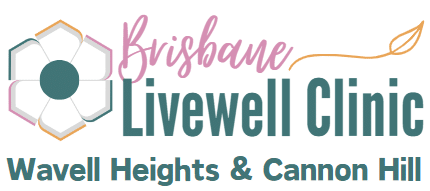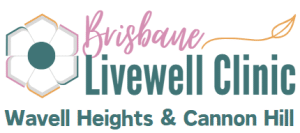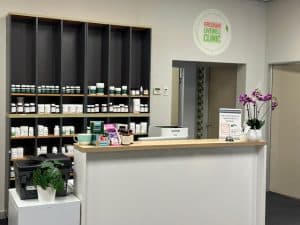Last Updated on 7 March 2024 by Brisbane Livewell Clinic
Iron Deficiency (Anaemia) is a condition that occurs when the number of red blood cells (RBCs) and/or the concentration of haemoglobin found in the red blood cells drops below normal levels (1). Red blood cells and haemoglobin are needed to carry and deliver oxygen from our lungs to the rest of our bodies. Without a sufficient supply of oxygen to our body, tissues and organs begin to be adversely affected. Symptoms of anaemia include tiredness, shortness of breath, dizziness and fatigue (1). Anaemia affects both men and women and can be classified as mild, moderate or severe depending on the extent to which RBCs and haemoglobin are decreased. People who are at the most risk of developing anaemia include women, those with a family history of anaemia, diets poor in iron and vitamins, chronic diseases such as inflammatory bowel disease (IBD), and those who have had significant blood loss from injury or surgery.
Iron Deficiency (ID) and Iron Deficiency Anaemia (IDA)
In the initial phases of iron deficiency (ID), iron intake does not reach the requirements (2), and as a result, absorption of iron increases to compensate. As iron deficiency (ID) continues, the production of red blood cells (RBCs) is impaired, leading to iron deficiency anaemia (IDA) (2).
The most common cause of anaemia is blood loss (2). In premenopausal women, menstruation is the most common cause of blood loss (3). In men and post-menopausal women, this is most likely due to medication use (such as aspirin), blood loss from surgery or injury or gastric ulcerations2. Other causes include (3)
- Poor dietary intake of iron
- Malabsorption issues (such as Coeliac Disease)
- Increased requirements (such as children due to rapid growth from birth until age 2 and adolescence, and adults during pregnancy and lactation)
Common causes of anaemia in infants and toddlers include preterm birth, low birth weight, exclusive breastfeeding after six months, inappropriate solid introduction with low iron sources, unfortified formula milk, and introduction of cow’s milk before one year of age (4).
Screening and Diagnosis
Anaemia is screened for during a full blood count (FBC) test done during a health examination. Iron studies give your doctor information about the size, shape and relative maturity of the blood cells present in your blood at that moment and therefore leading to the diagnosis of anaemia. The World Health Organisation (WHO) defines anaemia as a level of haemoglobin below 13.0g/dL in male adults, below 12.0g/dL in female adults who are not pregnant, and below 11.0g/dL in pregnant women5. Once a diagnosis of iron deficiency anaemia has been made, the cause of the deficiency should be identified because the underlying condition may require immediate treatment.
Treatment
There is clear evidence to support treatment in all patients presenting with anaemia as research has shown that treatment improves the quality of life and condition, and alleviates symptoms of fatigue, tiredness and weakness5. Treatment for anaemia is individualised, complex and involves a team approach.
Dietary Treatment by an Accredited Practicing Dietitian
As a Dietitian, one of our approaches to treatment for anaemia includes education about iron. Iron is a mineral found in haemoglobin and RBCs, which helps carry and transport oxygen around the body. Iron in food can be found in two types:
1. Haem Iron
Haem iron is the best source of iron as it is better absorbed in the body. Food that contains haem iron are animal sources, such as meats (beef, lamb, pork, kangaroo), poultry (chicken or turkey), fish/seafood, and offal (liver and kidney). The redder the meat, the more iron it contains.
2. Non-Haem Iron
Non-haem iron is not as easily absorbed by the body. Non-haem iron is found in plant sources, such as iron-fortified slices of bread and breakfast cereals, legumes (kidney beans, baked beans, chickpeas), green leafy vegetables, nuts and nut pastes, and eggs. Whilst non-haem iron isn’t absorbed as well as haem iron, it is the only source of iron in foods particularly for those who follow a vegetarian, vegan or plant-based diet.
Iron Enhancer: Eating Vitamin C-rich foods with your meal can increase the absorption of iron, particularly non-haem iron sources. Great sources of Vitamin C include fruits (orange, lemon, pineapple, strawberry), and vegetables (tomato, capsicum, broccoli).
Iron Inhibitor: Tea and coffee can block the body from absorbing iron, so best to avoid drinking these at the same time as your meal. Aim to have these at least 30 minutes after meals.
Iron Supplements: Iron supplements are not appropriate for everybody. It is recommended to have a conversation with your health professional to see if an iron supplement is required and suitable for you.
Want to learn more? These Blogs may also interest you. Click HERE or HERE or HERE









